Lobelia
Lobelia L.
Family: Lobeliaceae
Common names:
Introduction
A large cosmopolitan genus of many garden ornamentals of which the popular Lobelia erinus is one of the sixty-nine species native to South Africa.

Description
Description
Species in this genus are blue-, purple-, white- or pink-flowering annuals, perennial herbs, and small shrubs.

The leaves are alternate, simple, and without stipules, often containing a watery or milky sap. The flowers are irregular and bisexual, and are borne singly or in racemes, umbels or spikes. Petals, sepals and stamens are in fives. The petals are fused, forming a two-lipped corolla which consists of spreading lobes and a split tube. The upper lip consists of two often smaller and erect lobes and the lower lip of three spreading lobes. The petals are inserted on a two-chambered inferior ovary and the stamens are attached to the base of the corolla. Filaments are fused at least half of their length and anthers are fused into a tube around the style. Anthers are often tipped with a tuft of short hairs. The style is simple with as many stigmatic lobes as carpels. The fruit is a dehiscent capsule.
Distribution and habitat
Distribution description
Lobelia, comprising more than 360 species, has a cosmopolitan distribution, although especially rich in the tropical and sub-tropical regions. Only 69 species occur in South Africa. The genus is found throughout the country and grows in a variety of habitats from sheltered to exposed rocky slopes, sand dunes, sandy flats, shady, damp, coastal mountain slopes and forest floors.
Ecology
Ecology
Lobelia flowers achieve cross-pollination by being protandrous (male reproductive organs mature first). The style pushes through the tube that is formed by the fused anthers and drives the pollen out at the top where it is collected by insects. After the style has emerged completely, the stigmatic lobes separate and the female stage of the flower begins. The stigma is now receptive to pollen from another plant. Pollinators include a variety of bees and butterflies.
Uses
Use
The long flowering period, ease of cultivation, and stunning flowers have made many Lobelia species popular in the horticultural industry.
A few species such as L. pinifolia, L. erinus, L. coronopifolia and L. flaccida have reportedly been used as medicinal plants. For example, the roots of L. pinifolia have been used in remedies for skin disease, chronic rheumatism and gout. The alkaloid lobeline is most likely responsible for the medicinal properties of Lobelia.
Growing Lobelia
Grow
Lobelias make excellent edging plants in flower beds or can be grown in containers and hanging baskets. L. erinus is the most widely cultivated species in the genus. It has been cultivated since the seventeenth century and commonly used in flowerbeds. The rare L. valida also makes an excellent bedding plant and is often planted in beds at Kirstenbosch garden. L. pteropoda from the Transkei area makes an attractive hanging basket specimen. Most species can easily be grown from seed.
Species
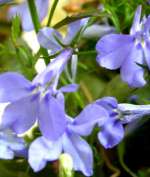
Lobelia erinus L.
Annual or perennial. Erect or spreading, growing up to 100 mm high. The leaves are rotund-ovate, spatulate or obovate-oblong, ± 10 x 4-8 mm. The inflorescence is in a loose raceme arrangement. Flower colour ranges from blue, violet, pink or white and mostly with white markings in the centre. The corolla is 8-14 mm long. The fruit is a capsule, obconical-oblong, 5-8 mm long. The flowering time is between September and December. The preferred habitat is lower mountain slopes and coastal flats. Distribution ranges from the Bokkeveld Mountains to tropical Africa.
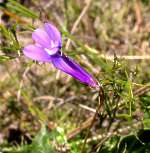
L. coronopifolia L.
A tufted shrublet, basally branched which grows up to 300 mm high. The leaves are sessile or sub-sessile, linear-lanceolate, 25-40 x 2-5 mm. The peduncle is axillary and terminal, generally 1-2-flowered. The corolla is purple-violet with exceptions of pink and white, glabrous, ± 20 mm long. The capsule is oblique-ellipsoid. The flowering period is between October and April. It occurs on sandy and stony flats as well as on lower mountain slopes. The species is mostly distributed in the Cape, especially Table Mountain but also occurs on the south and east coasts.
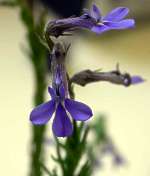
L. pinifolia L.
An erect shrublet which grows up to 300 mm high. The leaves are sessile, pointing upwards, 10-20 x 1-2 mm. Inflorescence is axillary and solitary. The corolla measures between 15-17 mm and is blue. The capsule is ovoid, 5 mm long. The flowering time is mainly between December and April and it prefers rocky slopes and flats. Distribution ranges from the Cape Peninsula to Riversdale.
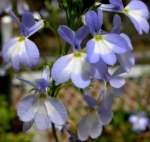
L. comosa L.
This soft, glabrous shrublet grows up to 0.5 m and is basally branched. The leaves are indistinctly petiolate or sessile, oblanceolate, 1.5-5.0 x 0.2-0.5 mm. The inflorescence is a raceme. The corolla is about 12 mm long and bright blue. The capsule is obconical. The flowering period is mainly August to January. Sandy, coastal slopes are preferred and the species ranges from Cape Peninsula to Caledon.
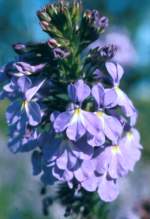
This species is commonly known as the galjoenblom . It is a soft, leafy shrublet and grows up to about 0.6 m high. The leaves are sessile, oblong-obovate, 40-100 x 4-18 mm. The corolla is deep blue, 17 mm long. The flowering time is between November and April. It occurs on the coastal hills of the Agulhas Plain from De Hoop to Stilbaai.
References
- Cupido, C.N. & Conrad, F. 2001. Lobelias in South Africa. Veld & Flora 83: 118, 119.
- Kovanda, M. 1978. Campanulaceae. In V.H. Heywood, Flowering plants of the world : 256. Oxford University Press, Oxford.
- Leistner, O.A.(ed.). 2000. Seed plants of southern Africa: families and genera. Strelitzia 10. National Botanical Institute, Pretoria.
- Powrie, F. 1998. Grow South African plants . National Botanical Institute, Cape Town.
Credits
Christopher Cupido & Lee-Anne Mannie
Compton Herbarium, Kirstenbosch
November 2004
Plant Attributes:
Plant Type: Bi/Annual, Perennial, Shrub
SA Distribution:
Soil type:
Flowering season:
PH:
Flower colour:
Aspect:
Gardening skill:
Special Features:
Horticultural zones






Rate this article
Article well written and informative
Rate this plant
Is this an interesting plant?
Login to add your Comment
Back to topNot registered yet? Click here to register.